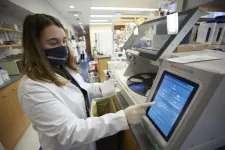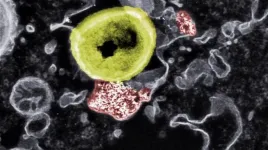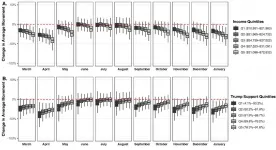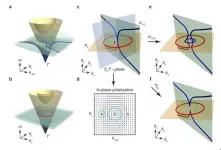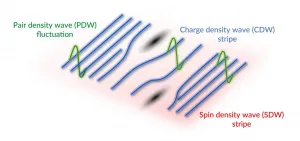(Press-News.org) SAN FRANCISCO, CA--April 21, 2021--Not all cancer cells within a tumor are created equal; nor do all immune cells (or all liver or brain cells) in your body have the same job. Much of their function depends on their location. Now, researchers at Gladstone Institutes, UC San Francisco (UCSF), and UC Berkeley have developed a more efficient method than ever before to simultaneously map the specialized diversity and spatial location of individual cells within a tissue or a tumor.
The technique, called XYZeq, was described online this week in the journal Science Advances. It involves segmenting a tissue into a microscopic grid before analyzing RNA from intact cells in each square of the grid, in order to gain a clear understanding of how each particular cell is functioning within its spatial location. This offers new insight into the organization of tissues and the interplay between different cell types during disease, including in cancers.
"What we have built is essentially a way to combine microscopy and single-cell analysis by sequencing," says Chun Jimmie Ye, PhD, associate professor of medicine at UCSF and lead author of the paper. "This technology gets us closer to being able to create a modern-day atlas of the human body. It lets us see not only what cells are included in a specific tissue, but where they are located within that tissue, what their relationships are, and how that changes with disease."
"I think we're actually taking a step toward this being the way tissues are analyzed to diagnose, characterize, or study disease; this is the pathology of the future," says Alex Marson, MD, PhD, one of the study's senior authors who is the director of the Gladstone-UCSF Institute of Genomic Immunology, and associate professor of medicine at UCSF.
Over the last decade, the advent of single-cell sequencing--which lets researchers analyze (or sequence) all the DNA or RNA contained in one cell at the same time--has shed new light on the diversity of cells within tissues. However, this technique, as well as experimentally integrating data about the cells' location, remains challenging using currently available methods. So, while researchers could see that a tissue contained a great diversity of cells, they didn't know how that diverse mixture of cells was arranged.
"What most people had been doing until now was taking a whole tissue, grinding it up, and then getting single-cell data from that mixture," says Youjin Lee, a postdoctoral scholar at Gladstone and co-first author of the new study. "Once the tissue is ground up, all information about the cells' spatial relationships is lost. With this new approach, we retain information about where each cell came from."
In XYZeq, a slice of tissue is placed on a slide that divides the tissue into hundreds of "microwells," each about the size of a grain of salt. Each cell in the tissue gets tagged with a molecular barcode--a short stretch of DNA--that's unique to the microwell it's contained in, like a neighborhood zip code. The cells are then mixed up and assigned a second barcode to ensure that each cell within a given square has its own unique identifier, like a street address within the neighborhood. Finally, the RNA from each cell is sequenced, and the results retain both barcodes to tell the researchers exactly where in the tissue it came from.
To test the utility and effectiveness of XYZeq, the team sampled tissue from mice with liver and spleen tumors. Their new approach let them visualize how cancer cells and healthy cells were arranged next to each other in the tissue samples.
However, that basic division--which could have been seen using other methods--wasn't all they could see. The team also found that some cell types located in the vicinity of the liver tumor weren't evenly spaced out; immune cells and specific types of stem cells were clustered in certain regions of the tumor. Moreover, certain stem cells had different levels of some RNA molecules depending on how far they resided from the tumor.
"This is a pattern we never would have been able to see without the spatial information that XYZeq conveys," says Derek Bogdanoff, graduate student at UCSF and co-first author of the study.
The researchers aren't sure yet what this pattern means, but they hint at the possibility that molecular signals generated by or near the tumor affect what nearby cells do.
This is the kind of spatial information that XYZeq was created to show. And the approach not only has promise in helping researchers untangle the roles of cells in the complex environment around a cancerous tumor, but in revealing cellular patterns in other organs and diseases. The brain, for instance, contains diverse cells whose physical arrangement influences how they communicate and store information.
To develop the XYZeq system, the researchers had to build each individual component, which required a large investment in time and machinery that is not available to all research groups. So, the team is now working on ways to scale up the technology to make it more accessible to other scientists.
"This technology generates spatially localized single-cell data that can be applied to tissues from different diseases," says Eric Chow, PhD, an assistant professor of biochemistry at UCSF and a senior author of the paper. "Eventually, that will help us move toward being able to use it in clinical settings as well."
INFORMATION:
About the Study
The paper "XYZeq: Spatially-resolved single-cell RNA-sequencing reveals expression heterogeneity in the tumor microenvironment" was published by the journal Science Advances on April 21, 2021: https://advances.sciencemag.org/content/7/17/eabg4755
Other authors include: Jonathan M. Woo, Cody T. Mowery, Eric Shifrut, and David N. Ngyuen from Gladstone and UCSF; George Hartoularos, David S. Lee, Yang Sun, James Lee, Sadaf Mehdizadeh, and Theodore L. Roth from UCSF; Yutong Wang, Hunter M. Nisonoff, and Yun S. Song from UC Berkeley; and Joshua Cantlon of Scienion.
The work was supported in part by the National Institutes of Health, National Science Foundation, California Institute for Regenerative Medicine, and JDRF Center of Excellence in Northern California.
About Gladstone Institutes
To ensure our work does the greatest good, Gladstone Institutes (https://gladstone.org) focuses on conditions with profound medical, economic, and social impact--unsolved diseases. Gladstone is an independent, nonprofit life science research organization that uses visionary science and technology to overcome disease. It has an academic affiliation with the University of California, San Francisco.
About UCSF
The University of California, San Francisco (UCSF) is exclusively focused on the health sciences and is dedicated to promoting health worldwide through advanced biomedical research, graduate-level education in the life sciences and health professions, and excellence in patient care. UCSF Health, which serves as UCSF's primary academic medical center, includes top-ranked specialty hospitals and other clinical programs, and has affiliations throughout the Bay Area. Learn more at ucsf.edu.
In rare cases, people who have been fully vaccinated against COVID and are immune to the virus can nevertheless develop the disease. New findings from The Rockefeller University now suggest that these so-called breakthrough cases may be driven by rapid evolution of the virus, and that ongoing testing of immunized individuals will be important to help mitigate future outbreaks.
The research, published this week in the New England Journal of Medicine, reports results from ongoing monitoring within the Rockefeller University community where two fully vaccinated individuals tested positive for the coronavirus. Both had received two doses of either the Moderna or the Pfizer vaccine, with the second dose occurring more than two weeks before the positive test. One person was initially ...
Fast reactions to future events are crucial. A boxer, for example, needs to respond to her opponent in fractions of a second in order to anticipate and block the next attack. Such rapid responses are based on estimates of whether and when events will occur. Now, scientists from the Max Planck Institute for Empirical Aesthetics (MPIEA) and New York University (NYU) have identified the cognitive computations underlying this complex predictive behavior.
How does the brain know when to pay attention? Every future event carries two distinct kinds of uncertainty: ...
COLUMBUS, Ohio - In the continuing search for dark matter in our universe, scientists believe they have found a unique and powerful detector: exoplanets.
In a new paper, two astrophysicists suggest dark matter could be detected by measuring the effect it has on the temperature of exoplanets, which are planets outside our solar system.
This could provide new insights into dark matter, the mysterious substance that can't be directly observed, but which makes up roughly 80% of the mass of the universe.
"We believe there should be about 300 billion exoplanets that are waiting to be discovered," said Juri Smirnov, a fellow at The Ohio ...
In the arms race "mankind against bacteria", bacteria are currently ahead of us. Our former miracle weapons, antibiotics, are failing more and more frequently when germs use tricky maneuvers to protect themselves from the effects of these drugs. Some species even retreat into the inside of human cells, where they remain "invisible" to the immune system. These particularly dreaded pathogens include multi-resistant staphylococci (MRSA), which can cause life-threatening diseases such as sepsis or pneumonia.
In order to track down the germs in their hidouts and eliminate them, a team of researchers from Empa and ETH Zurich is now developing nanoparticles that use a completely different mode ...
BOSTON - For many patients with localized lung cancer (non-small-cell lung carcinoma and small cell lung carcinoma), high-dose radiation with concurrent chemotherapy is a potential cure. Yet this treatment can cause severe, acute inflammation of the esophagus (esophagitis) in about one in five patients, requiring hospitalization and placement of a feeding tube.
A team of radiation oncologists at Mass General Cancer Center demonstrate in an early clinical trial that the radiation beam can be carefully "sculpted" to deliver the majority of a radiation dose directly to the tumor while effectively sparing tissues in the side of the ...
Ann Arbor, April 22, 2021 - Using nearly a year of anonymous geolocation data from 15-17 million cell phone users in 3,037 United States counties, investigators have found that individuals with lower income per capita or greater Republican orientation were associated with significantly reduced social distancing throughout the study period from March 2020 through January 2021. Their findings are reported in the American Journal of Preventive Medicine, published by Elsevier.
The associations persisted after adjusting for a variety of county-level demographic and socioeconomic characteristics. Other county-level characteristics, such as the share of Black and Hispanic residents, were also associated ...
Topological photonics has attracted a lot of attention recently. The application of topological band theory to photonics not only opens the door to novel devices, but also stimulates the exploration of new topological phases. In the photonic regime, symmetries that are unique to electromagnetic (EM) waves can intrinsically protect the band degeneracies in the momentum space. Topological systems realized using such symmetries are uniquely "photonic", having no counterparts in electronic or phononic systems.
Among various topological features in momentum space, nodal chain is a special ...
Guilt and social pressure lead people to underreport COVID-19 protocol violations, according to study of experimental data across 12 countries.
Article Title: A guilt-free strategy increases self-reported non-compliance with COVID-19 preventive measures: Experimental evidence from 12 countries
Funding: J.-F. Daoust acknowledges the financial support from SSPS Open Access (University of Edinburgh). M. Foucault and S. Brouard acknowledge the financial support from ANR - REPEAT grant (Special COVID-19), CNRS, Fondation de l'innovation politique, as well as regions Nouvelle-Aquitaine and Occitanie. Richard Nadeau and Éric Bélanger acknowledge the financial support from the Social Sciences and Humanities Research Council (SSHRC/CRSH). M. Becher gratefully acknowledges ...
Unconventional superconductors contain a number of exotic phases of matter that are thought to play a role, for better or worse, in their ability to conduct electricity with 100% efficiency at much higher temperatures than scientists had thought possible - although still far short of the temperatures that would allow their wide deployment in perfectly efficient power lines, maglev trains and so on.
Now scientists at the Department of Energy's SLAC National Accelerator Laboratory have glimpsed the signature of one of those phases, known as pair-density waves or PDW, and confirmed that it's intertwined with another phase known as charge density wave (CDW) stripes - wavelike patterns of higher and lower ...
Substantial proportions of pregnant and postpartum women scored high for symptoms of anxiety, depression, loneliness and post-traumatic stress in relation to COVID-19 in a survey carried out in May and June 2020, according to a new study published this week in the open-access journal PLOS ONE by Karestan Koenen and Archana Basu of Harvard T.H. Chan School of Public Health, US, and colleagues.
Pregnant and postpartum women face unique challenges during the COVID-19 pandemic that may put them at elevated risk of mental health problems. These include concerns about ...
